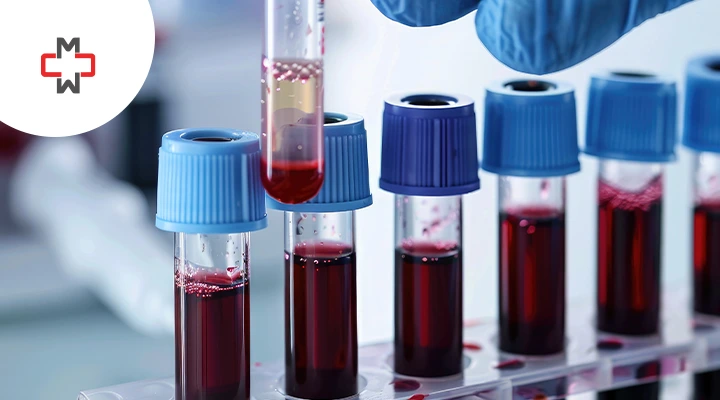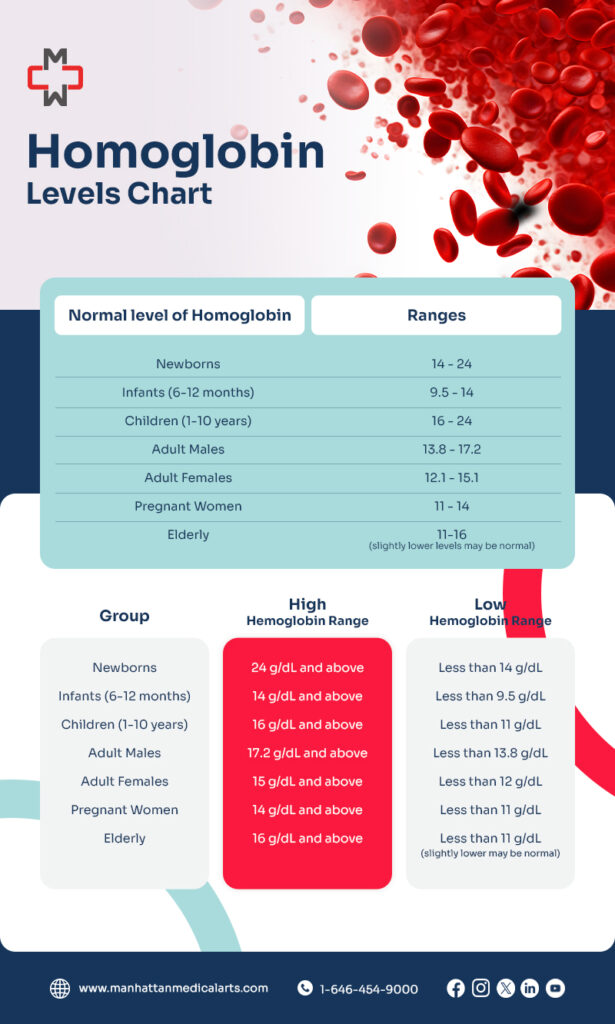Hemoglobin levels are crucial for oxygen transport in the body and can vary by age, gender, and overall health. These variations reflect the needs of different life stages, from higher levels at birth to gradual changes with aging. Monitoring hemoglobin helps detect conditions like anemia or polycythemia, which require medical attention. This guide explains hemoglobin’s role, normal ranges for different age groups, and the impact of high or low levels.
What is Hemoglobin?
Hemoglobin, found in red blood cells (RBCs), carries oxygen from the lungs to the rest of the body and returns carbon dioxide to the lungs for exhalation. Healthy red blood cells rely on adequate hemoglobin for proper function. Measured in grams per deciliter (g/dL), hemoglobin levels indicate the body’s oxygen balance.
Each hemoglobin molecule can bind to oxygen, ensuring effective oxygen delivery, energy production, and overall health. A healthy hemoglobin count is essential for maintaining good health.
How Hemoglobin Levels Are Tested
Hemoglobin levels are typically measured through a blood test, which helps assess the amount of hemoglobin in red blood cells. The two most common methods for testing hemoglobin levels are:
- Complete Blood Count (CBC): This test measures the total amount of hemoglobin in your blood, along with other components like red blood cell count and hematocrit. The CBC provides a snapshot of your overall health and helps doctors evaluate hemoglobin levels about other blood parameters.
- Hemoglobin Electrophoresis: This test detects abnormal forms of hemoglobin, such as those seen in sickle cell disease or thalassemia. It separates the different types of hemoglobin in the blood to identify unusual patterns or mutations.
How a Blood Sample is Taken
A healthcare provider takes a blood sample and sends it to a lab for analysis. The hemoglobin level is measured in grams per deciliter (g/dL) to determine if it falls within the normal range for your age and sex.
Interpreting Test Results
Test results help identify imbalances. Low hemoglobin levels may indicate anemia, while high levels can suggest polycythemia or dehydration. Regular testing is essential for early detection and timely treatment, particularly for those with risk factors like chronic illness or pregnancy.
Normal Hemoglobin Levels by Age
Hemoglobin levels vary by age, gender, and health status. Below is a general guide to the normal hemoglobin range by age:
| Age Group | Normal Hemoglobin Levels (g/dL) |
| Newborns | 14-24 |
| Infants (6-12 months) | 9.5-14 |
| Children (1-10 years) | 11-16 |
| Adult Males | 13.8-17.2 |
| Adult Females | 12.1-15.1 |
| Pregnant Women | 11-14 |
| Elderly | 11-16 (slightly lower levels may be normal) |
Hemoglobin levels fluctuate with age and health. Infants have higher levels to support growth, while older adults may see a slight decrease. Men generally have higher levels than women due to muscle mass and blood volume differences. Pregnancy and chronic illnesses can also impact hemoglobin levels, with pregnant women often having lower levels and chronic conditions potentially leading to anemia.
Low Hemoglobin Levels
Low hemoglobin levels are commonly associated with anemia, which can result from iron deficiency, chronic diseases, or significant blood loss. Symptoms of low hemoglobin levels include fatigue, dizziness, pale skin, and shortness of breath. Hemoglobin levels below 10 g/dL are considered dangerously low and require medical attention.
Types of Anemia
- Iron-deficiency anemia: Caused by insufficient iron intake or absorption.
- Vitamin B12 deficiency anemia: Linked to inadequate dietary intake or malabsorption.
- Anemia of chronic disease: Often associated with long-term illnesses like kidney disease.
Treatment depends on the cause and may involve iron supplements, vitamin B12 injections, or treating the underlying condition.
Sickle Cell Disease and Anemia
Sickle cell disease is a genetic disorder where abnormal hemoglobin (hemoglobin S) causes red blood cells to form a sickle shape. These cells can block blood flow and reduce oxygen transport, leading to symptoms like pain crises, fatigue, and organ damage. Management includes medications, blood transfusions, and lifestyle changes.
Sickle Cell Anemia is a severe form of sickle cell disease caused by defective hemoglobin S. Symptoms include extreme fatigue, frequent infections, and delayed growth in children. Treatment includes pain management, hydroxyurea medication, and regular health monitoring.
Thalassemia
Thalassemia is a genetic disorder that leads to anemia due to a hemoglobin mutation. It is classified into alpha-thalassemia and beta-thalassemia, depending on the affected hemoglobin chain. Both conditions result in symptoms like fatigue, pallor, and weakness. Diagnosis is made through blood tests, and treatment may include blood transfusions and iron chelation therapy.
Low Hemoglobin Levels in Pregnancy
Low hemoglobin levels are common during pregnancy due to increased blood volume and higher iron demands. Symptoms include fatigue, dizziness, and shortness of breath. Risks include preterm birth and low birth weight. Regular prenatal checkups, iron supplements, and consuming iron-rich foods are essential to prevent complications.
Preventing Anemia During Pregnancy: To prevent anemia, focus on iron-rich foods like spinach, kale, red meat, chicken, lentils, and fortified cereals. Iron supplements are often recommended, and regular blood tests help monitor hemoglobin levels. Prenatal vitamins are important for maintaining healthy hemoglobin levels, supporting both the mother and baby.
High Hemoglobin Levels
High hemoglobin levels can result from dehydration, smoking, living at high altitudes, or medical conditions like polycythemia vera. Elevated levels can increase blood viscosity, raising the risk of blood clots and cardiovascular complications.
Symptoms of High Hemoglobin Levels
Symptoms include headaches, dizziness, blurred vision, and high blood pressure. Additional signs may include flushed skin and difficulty concentrating. Immediate medical evaluation is recommended if these symptoms occur.
Treatment for High Hemoglobin Levels
Treatment options vary based on the cause and may include:
- Phlebotomy: Regular blood removal to reduce hemoglobin levels.
- Medications: Hydroxyurea for polycythemia vera.
- Lifestyle Changes: Quitting smoking, staying hydrated, and addressing underlying conditions.
Hemoglobin Levels FAQs
- What are normal hemoglobin levels in infants? Normal levels range from 14 to 24 g/dL in newborns, gradually decreasing over the first few months as the infant’s body adjusts.
- What are normal hemoglobin levels in children and adults? Normal levels range from 11 to 16 g/dL for children, 13.5 to 17.5 g/dL for adult men, and 12 to 15.5 g/dL for adult women.
- How can I increase my hemoglobin levels? Eat iron-rich foods like red meat, spinach, and fortified cereals. Vitamin C helps with iron absorption. If necessary, iron supplements can improve levels.
- What are dangerously low hemoglobin levels? Hemoglobin levels below 7 g/dL are considered dangerously low and require medical treatment to avoid complications.
- Can tobacco use affect hemoglobin levels? Yes, smoking reduces oxygen in the blood, lowering hemoglobin levels and leading to fatigue and breathing difficulties.
- Why are hemoglobin levels lower in females than in males? Females generally have lower levels due to menstrual blood loss, smaller muscle mass, and hormonal differences. Men have higher levels due to increased muscle mass and higher testosterone.
- Why do infants have high hemoglobin levels? Infants have higher levels at birth to meet their oxygen needs as they adjust to life outside the womb. This decreases over time as they grow.
- What is hemoglobin A1c? Hemoglobin A1c measures average blood sugar levels over 2-3 months. A level of 6.5% or higher typically indicates diabetes and helps manage long-term blood glucose control.
Conclusion
Maintaining balanced hemoglobin levels is essential for good health. Whether you’re addressing fatigue, or dizziness, or just want to ensure you’re in optimal health, understanding your hemoglobin is key. Regular blood tests and early action on abnormal results can prevent more serious health issues down the line.
Ready to take charge of your health? At Manhattan Medical Arts, we’re here to guide you with personalized care and expert advice. Don’t just wonder about your health—let’s tackle it together!
-
About The Author
Dr. Syra Hanif M.D.Board Certified Primary Care Physician
Dr. Syra Hanif is a board-certified Primary Care Physician (PCP) dedicated to providing compassionate, patient-centered healthcare.
Read More








